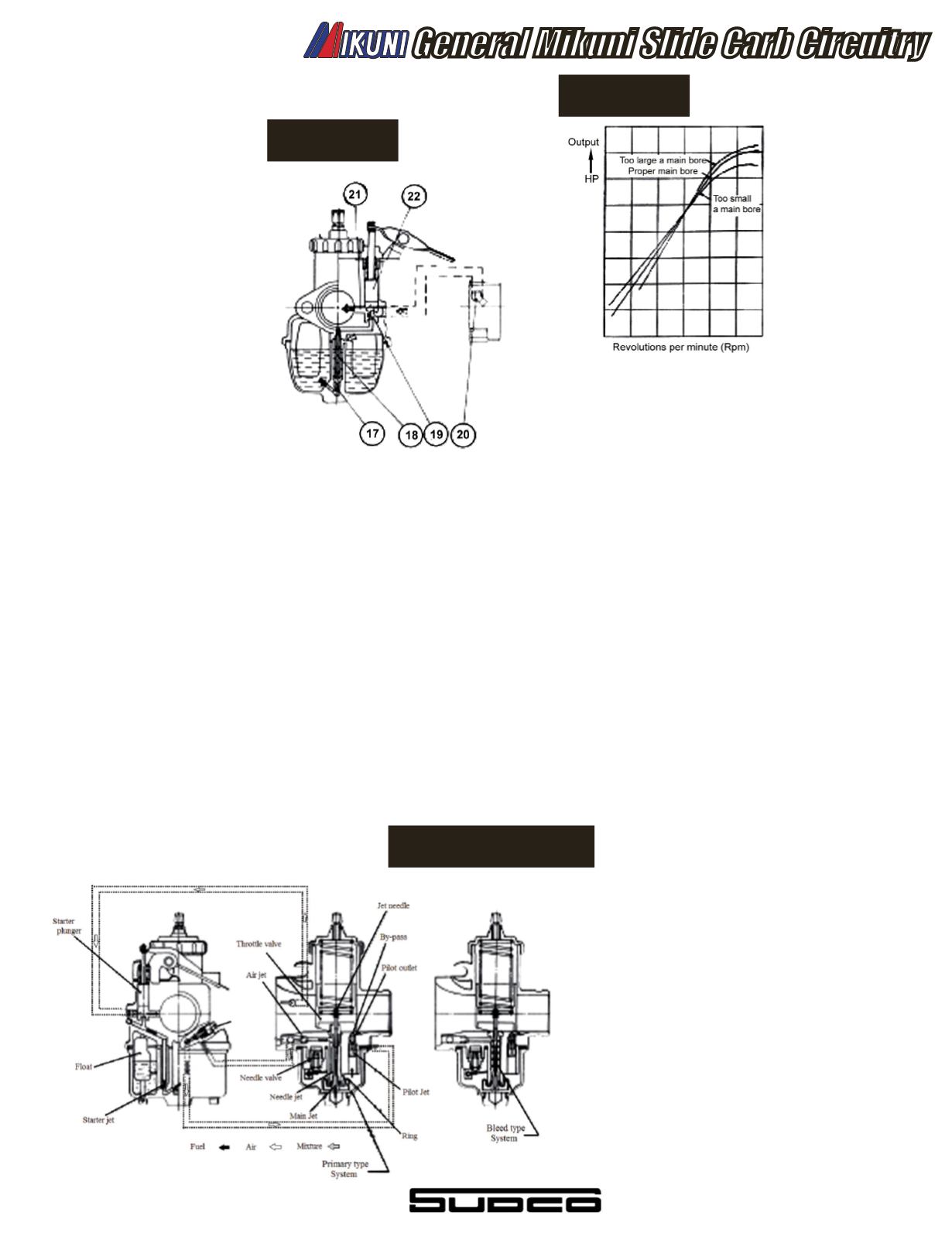

D. - Starter System (Fig.9)
Rather than a choke, an
enrichener type starter
system is employed for
Mikuni carburetors. The
enrichener starter type,
fuel and air, for starting
the engine are metered by
entirely independent jets.
The fuel metered by the
starter jet (17) is mixed
with air and is broken into
tiny particles in the emul-
sion tube (18). The mixture
then lows into the plunger
area (19), mixes again
with air coming from the
air intake port for starting
and is delivered to the
ngine in the optimum air-
fuel ratio through the fuel
discharge passage (21).
The enrichener is opened
and closed by means of
the starter plunger (22). Since the enrichener is constructed so as to
utilize the vacuum of the inlet passage (20), it is important that the
throttle valve is closed when starting the engine.
4. TUNE UP & CARBURETOR SELECTION
Turning up normally means a process of accurate and careful adjustments
to obtain maximum engine performance. Although, it means is a broad
sense, an economical improvement fuel consumption. Improvement of
power output of the engine depends on the amount of air drawn into the
cylinder per unit time. A practice generally followed for engine tune-up
includes:
1.) To improve suction eficiency and exhaust eficiency
by remodeling the intake and exhaust system.
2) To improve combustion eficiency by raising the compression ratio
3) To increase the number of revolutions by adjusting the ignition
timing
A. - Carburetor Main Bore Size Selection
One of the main prerequisites for improving the output is to
use a carburetor with a large a main bore as possible.
However, a large main bore alone does not necessary improve
the output. As shown in Fig. 10, it is true that a large main
bore improves the power output in high speed range. However,
in slow speed range, the output may drop. The main bore size
selection should be determined by various factors such as: (1)
whether the vehicle is intended for racing, (2) the design of the
engine, (3) rising technique of the rider, (4) the rider’s preference,
etc. In addition, the maximum output, the maximum torque, and
the maximum number of revolutions for stable engine operation
must also be taken into account Fig. 10 shows the values which
we have obtained throughout experience over the years.
Since the engine comes in a wide variety of types, the values
given in Fig 10 should be taken only as reference values.
5. Carburetor Setting
Once the main bore size of the carburetor is
determined. a test (normally referred to as setting
or matching) to select the proper jet or setting part
should be made. The size of the jet is determined
be measuring the output in a bench or in a chassis
dyno test. For racing it is best to determined the
proper size of the jet on the racing course.
The following points must be taken into account:
1) the altitude (atmospheric pressure),
temperature and humidity of the racing course.
2) The operation of the engine based on the topogra-
phy of the racing course.
3) Generally, carburetor tuning is done in four stages:
idle, low speed, mid-range, and high
speed in that order. With the Mikuni, each stage is
controlled by a separated component simplifying the
tuning process.
The engine cylinders need to take suficient air
and fuel mixed in proper amounts. The function
of a carburetor is to prepare and supply a mixture
of fuel vapor and air to the engine cylinders in the
proper ratio for eficient combustion.
General Mikuni Slide Carb Circuitry
Figure 9
Figure 10
Air/Fuel Mixture
539
















